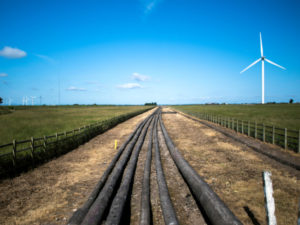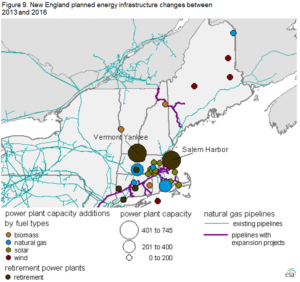
There’s an ocean of natural gas in Pennsylvania’s Marcellus Shale formation, but you wouldn’t know it based on the paltry natural gas infrastructure running from the area into the nearby population centers of the Northeast. Despite troves of cheap natural gas only a short way away over land, 20% of New England’s natural gas is delivered via expensive liquefied natural gas (LNG) shipments to Boston’s Everett LNG terminal. Freight Waves, an industry journal, reports that in Westchester County, New York, nearly on top of the Marcellus Shale play itself:
Con Edison (ED: NYSE), a New York utility provider, announced on January 18 a moratorium on new natural gas customers in Westchester County, beginning on March 15. The reason given by the utility was “new demand for gas is reaching the limits of the current supplies to our service area.” Politico reported that New York State’s reluctance to construct new natural gas pipelines is preventing adequate supplies from reaching growing economic centers in New York City, Long Island and Yonkers.
But in New England, things are even worse. Politicians have mandated a shift away from coal, placing the burden of the region’s energy production on natural gas. Those same politicians however, have prevented any new supplies of gas from getting to the region via pipeline. Freight Waves reports:
“The New England states used to be dependent on coal, oil, nuclear and hydroelectricity,” said Dan Kish, senior fellow at the Institute for Energy Research. “And they’ve shifted quickly to natural gas for generation, and they’ve shifted so fast that its caused huge draws of natural gas into the system [pipelines] without increasing infrastructure.”
Kish said that the United States is the world’s largest producer of natural gas and has among the lowest natural gas prices, especially in regions where natural gas is produced. He blamed the lack of supply in New England on political opposition to the use of fossil fuels.
Instead, New England’s politicians have spent their time endorsing “green energy.” Despite promises that such ventures would be sustainable, they have proven themselves anything but. The Wall Street Journal reports on the failed wind turbines of Falmouth, Massachusetts, writing:
In 2009 and 2011, Falmouth broke ground on two wind turbines on 314 acres of city land next to the wastewater-treatment facility and dog pound. It paid for the first turbine with a $5 million, 20-year municipal bond, and it received $5 million in federal stimulus money to build the second. Falmouth planned to sell some of the energy it generated to the electrical grid of utility company Eversource, formerly known as NStar, so the city anticipated the turbines would generate $1 million to $2 million in annual profit.
Residents quickly grew disillusioned. The turbines rose nearly 400 feet, and light flickered eerily through the blades, which whirled in a circle big enough for a 747. Barry and Diane Funfar, who lived fewer than 1,700 feet away, began suffering from headaches.
Ms. Funfar struggled to sleep, and her husband’s heart started to pound. “The problems were unbelievable,” Ms. Funfar says. “Barry couldn’t live with them. He was bothered every minute [the turbines] were running. I was bothered, too.”
The couple built their home themselves in 1979, and their adult children live nearby, so they didn’t want to leave. Mr. Funfar complained to the city, and he was “no lone voice crying in the wilderness,” according to court records. The Funfars sued, as did other residents who reported hearing “thunderous and thumping” noises and feeling “powerful pulses, which are characteristic of low-frequency sound.” A real-estate appraiser testified that homes close to the turbines had lost 20% of their value.
In 2015 the Massachusetts Appeals Court ordered Falmouth to turn off one of its turbines, ruling that it lacked proper permitting. And in 2017 Barnstable County Judge Cornelius Moriarty ordered both turbines shut down as a public nuisance. “We had our home paid for before the turbines, and now we owe more than it’s probably even worth—over $500,000,” Ms. Funfar says. “We wanted to leave it to our kids, but if we died today, our kids couldn’t afford the home.”
Falmouth is taking a “daunting” financial hit, says town manager Julian Suso. Insurance covered most of Falmouth’s legal fees and nuisance settlements, but the remaining liability is “certainly in excess of $100,000,” he says. On Jan. 15, selectmen voted 4-1 against relocating the turbines within town limits, with one abstention. It will cost between $1 million and $2 million to dismantle and remove them.
Falmouth’s turbine fiasco isn’t an isolated incident. Other New England towns have faced hard realities after spending scarce taxpayer resources on green dreams (see here and here for two such examples). The residents of Cape Cod were lucky enough to avoid plans to develop offshore wind there before they got started.
I have written to you lately of the recent natural gas outage in Newport, Rhode Island. Tim Horan, President of National Grid’s Rhode Island operation said of the outage, “This appears to be a lack of gas transmission supply to our system.” This isn’t the first time in recent years that low supply in the New England natural gas grid has caused problems. Last year, New England’s power grid, powered mostly by natural gas, was straining as natural gas was diverted to feed demand for heating during a cold snap. VPR reported then:
Gordon van Welie, head of ISO New England, has said for a while now the Northeast has a natural gas problem.
On the coldest days, lots of natural gas gets diverted to heat homes. For power plants, that means high spot prices and less fuel to make electricity.
In a report released last week, ISO New England mentions “rolling blackouts” if the future grid is unable to meet winter demand. That statement was met with divergent reactions from several energy and advocacy groups.
“We’re very close to the edge in New England,” van Welie told lawmakers. “We need to find a way of relieving this constraint one way or another. Either through investment in the pipeline infrastructure, or continued investments in other sources of energy that will take the pressure off the gas pipeline, or reducing demand on the system.”
Van Welie told senators in 2013 more gas pipes were needed to solve the problem.
Several attempts to do that failed, and today, van Welie said expanded capacity is unlikely to happen in the near future.

You can see on the map to the right that New England has retired major sources of energy without replacing them with other options. Planned expansions to pipelines in the region haven’t happened, and no new capacity has been existed. Without increased natural gas infrastructure in New England, problems are likely to persist.
Originally posted on Your Survival Guy.



